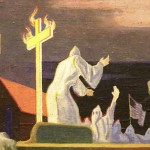The tragic outcome of the Jonestown Agricultural Project is well known. A thorough understanding of the 1978 massacre of more than 900 people in Guyana, however, remains elusive—as does common knowledge of the group’s roots and its leader. Jim Jones called Indiana home for the first 34 of his 47 years. Born in Crete in 1931, James Warren Jones was raised in Lynn, another small town in Randolph County. Jones mother, committed to progressive causes, worked to support the family; while it has been speculated that his father, a disabled WWI vet, had ties to the Ku Klux Klan. When Jim’s parents divorced in 1945, he moved with his mother to Richmond, where he graduated from high school in 1949. Enrolling in Indiana University, Jones subsequently transferred to Butler University, although he did not receive his bachelor’s degree until 1961.
In the meantime, Jones had gotten married and taken up preaching. Beginning as a student minister in the Methodist Church, Jones abandoned that congregation when it refused membership to African-Americans. Using funds earned selling pet monkeys door-to-door, Jones started his own Pentecostal-style church under the name Wings of Deliverance. Renamed the Community Unity Church, Indianapolis’ first biracial church opened its doors at Hoyt Avenue and Randolph Street in 1954.
(Theatre-goers may be aware that the church at St. Clair Street and Park Avenue that now houses the Phoenix Theatre was another place Jones preached.) Emerging in 1956 as The People’s Temple Full Gospel church at 1502 North New Jersey Street, Jones’ ministry promoted racial equality and social activism, operating soup kitchens, nursing homes, and facilities for the disabled. On the home front, Jones and his wife made headlines as the first white couple in Indiana to adopt a black child, the first of five non-white children they brought into their family. Jones’ efforts to promote racial harmony were hailed by the Indianapolis Recorder, the city’s African-American publication. He was appointed chair of the Indianapolis Human Rights Commission in 1961, and is credited with having used the post to desegregate municipal institutions and private businesses alike.
Although the People’s Temple gained membership in the Christian Church in 1960 when it was recognized by the Disciples of Christ, who subsequently ordained Jones, his ministry was an eclectic mix of faith healing and socialist politics that ultimately shunned white Christianity and the Bible. Jones asked his followers not only to call him “Dad” or “Father,” but to consider him an incarnation of God.
Several years after Jones had transplanted his inner flock to California, the Indianapolis Star published the first expose of Jones, who was by this time a well-respected figure in San Francisco politics. The 1971 piece revealed the excesses and the apparent deceptions of the “miracle healing services” held at People’s Temple in downtown Indianapolis. Subsequently, the Star assigned its leading investigative reporter to the case. By 1974, facing increasing scrutiny from the media, Jones had already arranged for the exodus to Guyana.
l






















